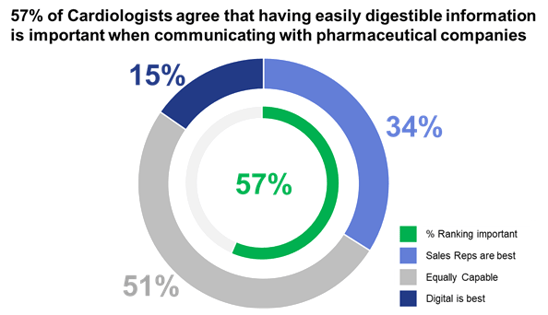This article explores the needs and preferences of EU cardiologists in terms of the digital information and engagement with pharmaceutical manufacturers including the results an an EU-wide survey of over 600 cardiologists.
Pharmaceutical marketing teams can also register to receive the results from a new global survey of cardiologists that assesses the digital content currently being received by leading manufacturers (via the registration form at the bottom of the article)
Pharmaceutical marketing to cardiologists, like all therapeutic disciplines, has shifted considerably over recent years. Rapid developments in technology and digital communication, changes in healthcare professional attitudes to sales force visits, and drug patent expiry have all played a role. The COVID-19 pandemic has had rapid and dramatic effects on healthcare systems across Europe, and cardiologists are going to be under particular strain moving forward. With Healthcare systems now navigating their path to a ‘new normal’, it’s become increasingly clear there is a pressing need to take advantage of digital health opportunities.
Online conferences and presentations are growing in popularity due lockdown and social distancing measures, leading to widespread cancellation and postponement of medical education events. In fact, this year the European Society of Cardiology (ESC), the largest medical congress in Europe, have announced its plans on holding the ‘ESC Congress 2020 digital experience’.
The pandemic also poses an obvious threat to the face-to-face nature of sales reps, which, along with major congresses being cancelled, means the major routes pharmaceutical companies contact physicians has disappeared.
As a result, we are likely to see this time act as a catalyst for moving the sales force into digital spaces. Reps will be reliant, now more than ever, on making use of existing online channels for virtual contact and adopting remote engagement strategies with their physicians.
With already growing difficulty in securing face-to-face visits with healthcare professionals in recent years, the pharmaceutical industry is responding with the increased use of digital platforms, yet Europe still lags behind the US and Japan in the uptake of digital marketing – the volume share of digital promotional activity is just 11% compared with 21% in the US and 47% in Japan.
In fact, only 7% of Cardiologists in Europe stated they typically use digital methods for sales reps meeting, despite preferring to access much of their information, such as clinical trial updates and pharmaceutical news, online.
A better understanding of physician preferences can allow pharma marketing efforts to be shaped according to their changing needs. Bryter recently surveyed +600 cardiologists across Europe to identify the most critical factors when communicating with pharmaceutical companies.
Most valued by cardiologists overall was content that was easily digestible and receiving an immediate response to their questions, followed by communications that fit in with their schedule.
However physicians demonstrated evident market variation –In Denmark and Sweden there is a much more pressing demand for having immediate response to their questions, which was rated most important by 63% and 65%, while in Spain it was felt most important for communications to fit in with their schedule (55%). Furthermore, in Switzerland over half expressed it was important that they don’t have to seek information out, instead wanting it proactively delivered to them, while in Belgium 46% also stated it was important they receive information that is tailored to them.

Most importantly, all physicians want this process to be as effortless as possible, with information that is both easily accessible and easy to understand.
With the current climate demanding an increasingly digitalised landscape, optimising the use of digital engagement approaches requires an understanding of how digital media compares with cardiologists’ experiences of sales reps.
To address this, Bryter researched how these different formats compare with each other, and found that the majority of physicians are neutral – feeling that both reps and digital are equally able to communicate these types of information. Physicians remain unconvinced of the ability of digital channels to not only provide them with the same support that reps offer them, but to enhance their interaction with pharmaceutical companies.

What’s more, some markets present a more significant challenge than others in adopting digital approaches. In Belgium, there is a greater preference for face-to-face meetings with sales reps, and minimal faith in the abilities of digital to effectively deliver different types of information. Almost three quarters of cardiologists would prefer to have a rep meeting face-to-face than digitally. In Denmark and Sweden, cardiologists are more likely to view the abilities of reps and digital media equal, whereas in Spain cardiologists are by comparison much more open to digital communications, viewing this approach much more positively.
So, how can pharmaceutical companies take advantage of digital strategies to evolve their sales approach? Pharmaceutical companies need to adapt to this changing landscape. Digital cannot replace sales representatives - nor does it need to. Multichannel engagement provides the opportunity to bridge the gap between the increasingly infrequent and sparse face-to-face visits with the convenience and flexibility of digital.

Digital channels can be used for real-time communication with physicians even more regularly than periodic face-to-face visits. E-detailing is already an established means of allowing efficient engagement, interactivity, and convenience at a lower cost.
Digital marketing materials can be used to offer meaningful and engaging content that cuts through the noise, helping to ensure pharmaceutical companies maintain a connection with, and awareness among physicians when it suits their schedules. Content can be optimised, updated, and tailored to remain relevant to physicians.
If used in the right way, digital strategies can keep reps connected with physicians more closely than ever. The challenge is in proving to physicians that digital can provide them with the same support that sales reps offer.
This is critical as it seems increasingly unlikely everything will simply return to the status-quo, with industries being thrust into the digital space. Instead, this is likely to be a turning point for pharma to embrace digital marketing where there has been hesitancy before, now being faced with the choice to sink or swim.
Pharmaceutical companies must have in-depth knowledge of how they should be communicating and connecting with physicians. By gaining a greater understanding of physician attitudes, behaviours, motivators, prescribing habits and preferred information channels through market research, pharmaceutical companies can allow their sales reps to deliver an optimal customer experience tailored to physician and market needs.
Pharmaceutical marketing teams and researchers looking for additional insight and guidance on how to optimize digital content in cardiology can register to download the findings from a new global survey here. The report identifies the key drivers of satisfaction with the digital content and ranks the leading companies based on the content they deliver (including AstraZeneca, BMS, Merck, Novartis, Pfizer, Roche and Sanofi)
Read more
Read more about innovation in digital health and its impact on patient experience and the delivery of healthcare




